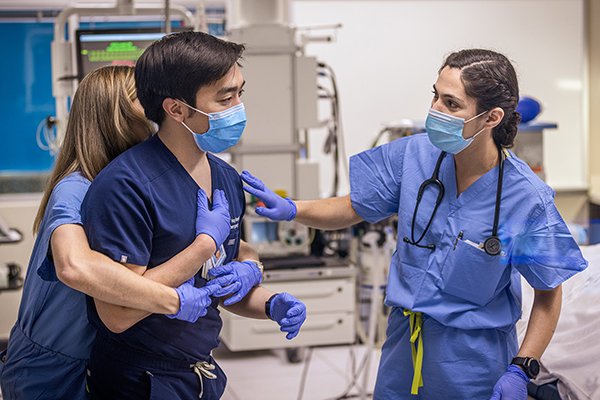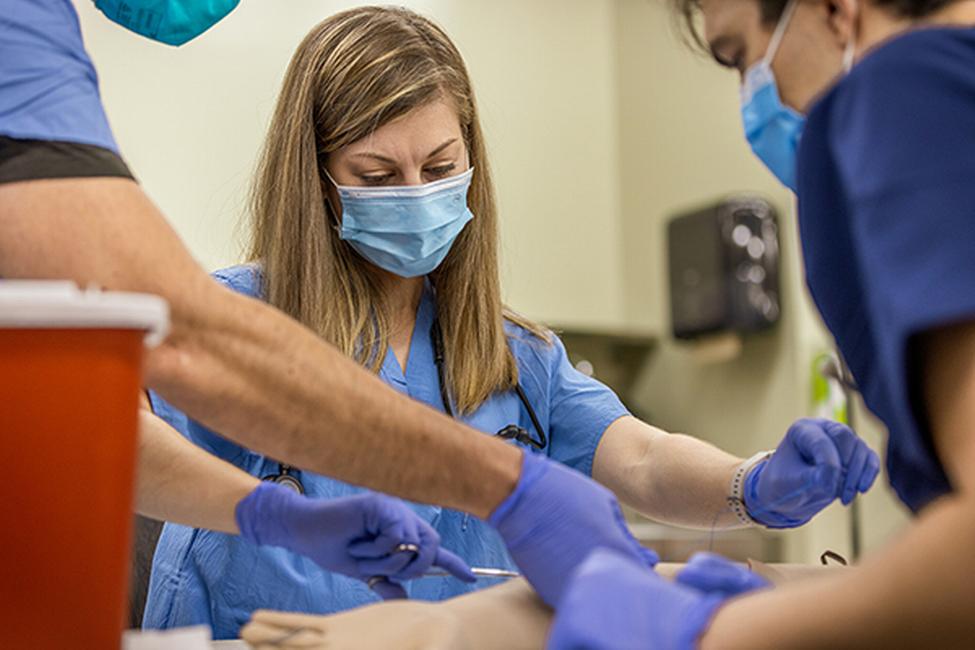Emergency Medicine provides training to SpaceX crewmembers


Along with educating students, residents, and fellows in the most advanced lifesaving therapies on Earth, the Department of Emergency Medicine is helping to prepare members of the Polaris Dawn crew to handle medical emergencies in space. The Department of Emergency Medicine, which has been training NASA astronauts in emergency medical care for more than 20 years, recently welcomed SpaceX’s Polaris Dawn medical officer, Anna Menon, and mission specialist Sarah Gillis for a weeklong space medicine training session.
“Our space medicine program is rapidly expanding the capabilities of what astronauts can do in space when they encounter a medical problem. Even minor medical problems in space can become extraordinarily complex to treat,” said Bentley Bobrow, MD, professor and chair of the Department of Emergency Medicine, John P. and Kathrine G. McGovern Distinguished Chair, and Nancy, Clive and Pierce Runnells Distinguished Professor in Emergency Medicine.
“Spaceflight crews are starting to evolve and look very different than crews of the past, whether it’s their technical backgrounds or even overall crewmember health,” said Jared Isaacman, commander of Polaris Dawn. “The space medicine programs at SpaceX and UTHealth Houston are focused on this exciting frontier, developing new methods of training and new tools to support this diverse population as they seek to live, work, and explore low-Earth orbit and beyond.”
Under the direction of Nicolas Heft, MD, emergency medicine resident, the training included lectures, simulations, and applications of fundamental emergency medicine procedures, beginning with how to gather a patient’s history and perform a physical exam. Heft and his team trained Menon and Gillis in the clinical skills laboratory on airway interventions, such as chin tilt-jaw thrust, placing supraglottic airways, and using a bag valve mask to ventilate a comatose patient.
In addition to preparing the crewmates for the physiological adaptations experienced in spaceflight, training included high-fidelity, hands-on training with ultrasound technology, something the crew may use in both a diagnostic capacity as well as for research purposes. They also learned how to diagnose and treat commonly encountered problems such as eye injuries, administer shots to treat space motion sickness, repair minor wounds and lacerations, and assess and manage urinary and kidney function (a source of significant medical risk in spaceflight).
“Flight surgeons in mission control can provide medical support to the crew, but in order to work effectively together, our crew needs to know how to perform initial medical assessments and efficiently communicate with the ground team,” said Menon.
In order to prepare the Polaris Dawn crewmembers for the first-ever commercial spacewalk, the training also allowed Menon and Gillis to experience the hyperbaric chamber at Memorial Hermann-Texas Medical Center and familiarize themselves with hyperbaric medical treatment of decompression sickness. They also toured Memorial Hermann’s Life Flight to get an up-front look at how emergency medicine is practiced in a dynamic and confined environment.
“The UTHealth Houston program provided a real-world, hands-on experience that is instrumental in transforming the required knowledge from theory to practice and cementing our training,” Gillis said.
SpaceX’s Falcon 9 rocket will launch the Polaris Dawn mission from Launch Complex 39A at Kennedy Space Center in Florida no earlier than November of this year.